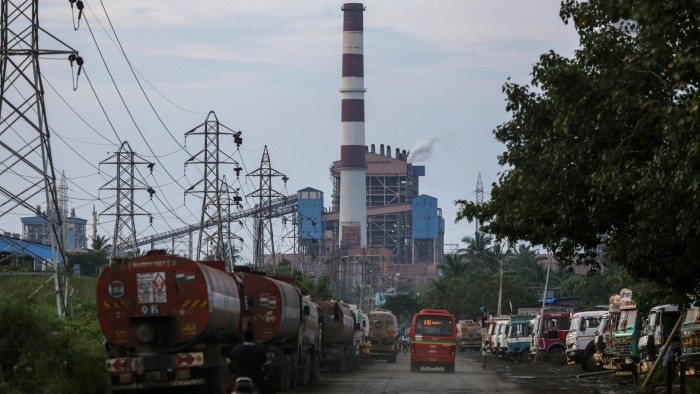The decades-old coal-fired Trombay power plant stands on Mumbai’s eastern waterfront, shrouded in smoggy haze and flanked by oil refineries. The facility — a potent symbol of an enduring reliance on polluting energy — fuels the skyscrapers and homes of India’s financial capital.
India’s energy-hungry economy is sucking up more electricity than its green sources can provide, despite the billions of dollars invested in solar and wind farms by conglomerates such as Adani Group and Tata Sons, whose energy arm Tata Power operates the Trombay plant.
That means the world’s third-largest carbon emitter, after the US and China, remains wedded to its abundant coal power for more than 70 per cent of its electricity generation.
At the same time, the country is being ravaged by weather extremes from the world’s changing climate. Punishing heatwaves, for example, have prompted better off citizens to invest in air conditioners, exacerbating the problem.
“India’s situation is actually highlighting the complexity of energy transition,” says Nandini Das, a climate and energy economist at Climate Analytics, a research institute. “India still has a very deep focus on coal.”
The problem is acute for the country as it industrialises its economy, subsidising both carbon-heavy businesses and renewable sectors to promote their growth, in a bid to become a manufacturing hub that can steal market share from its Asian rival, China.
Over the past three years, this has helped to turn solar and wind energy into its cheapest form of electricity.
The switch came about after Prime Minister Narendra Modi set out plans to reach net zero by 2070 and his administration began pushing to make renewable sources half the energy mix by 2030.
“Currently, electricity from large renewable energy plants is much cheaper than new coal-based power plants, making it a win-win for both [the] climate and the economy,” says Nandikesh Sivalingam, director at the Center for Research on Energy and Clean Air, a research organisation.
However, India’s increasing use of coal to make up for shortfalls in electricity drove production and imports to a record in the first half of 2024, and is a “drag” on its green ambitions, according to scientific group Climate Action Tracker. It rates the nation’s climate targets and climate action as “highly insufficient”.
India’s share of global greenhouse gas emissions increased to 7.5 per cent in 2022, from 6.7 per cent in 2019, according to rating agency Moody’s, which now forecasts that power consumption will rise 46 per cent to 2,524 terawatt hours by 2031.
The agency also estimates that India will need extra funding of up to $215bn over the next seven years to bridge its renewable financing gap so that it can install around 44 gigawatts each year to hit its target of 500GW of green energy.
Christian de Guzman, senior vice-president at Moody’s, says that, while India’s progress has been “tangible and . . . frankly, quite impressive given the pace of growth in this economy, they’re not investing enough basically to meet their medium-term decarbonisation goals”.
Modi’s government, which faces multiple spending demands, cannot be expected to “fully plug” that amount, de Guzman adds.
India’s green transition is also clashing with political and economic realities. Only about 2 per cent of passenger vehicles sold in India are battery-powered. They are more expensive than combustion-engine vehicles and their charging and battery-swapping infrastructure is limited, hindering the industry’s growth in a country where GDP per capital is less than $3,000.
At the same time, India faces an employment crisis with a chronic shortage of formal jobs, raising questions about how it will provide work for millions, as well as support farmers. Agriculture accounts for about 22 per cent of India’s emissions, which is double the world average, with livestock’s methane emissions and dairy making significant contributions, Moody’s says.
“The agenda of decarbonisation should not end up costing us,” argues Amir Bazaz, head of infrastructure and climate at the Indian Institute for Human Settlements.
Still, the world’s most populous nation faces pressure from abroad and Indian officials bristle when questioned on their climate commitments. They say developed nations are responsible for historical emissions and countries such as India are morally right to use whatever energy source is readily available so they can catch up economically.
Finance minister Nirmala Sitharaman recently denounced the EU’s planned carbon tax on imports, which will be levied from 2026, as “stifling”.
“We keep reminding ourselves in India that the emissions per capita is only a third of what the average emission per capita is globally,” she told the Financial Times’ Energy Transition Summit India in New Delhi in October.
But Das at Climate Analytics calls that mindset “very naive”, given India’s extreme climate vulnerability, as evidenced by increasing flooding and brutal temperatures.
In August, however, PM Prasad, chair of state-owned Coal India, which accounts for about 80 per cent of the country’s output, said his “vision is to ensure that there is no shortage of coal” and that “despite the country’s deep commitment to renewable energy, for climate change considerations, coal [will] continue to be pivotal for [a] few more years”.
With power cuts disrupting even India’s most affluent cities, Modi’s government is on board with that future, too. It has drawn out the lifespan of ageing thermal plants and wants to open 100 new coal mines with a production capacity of 500mn tonnes per annum by 2030 — to achieve Aatmanirbhar Bharat, or ‘a self-reliant India’, in fossil-fuel power generation.
“We are going to add more carbon dioxide into the atmosphere; it’s us who are going to be impacted,” says Das. “It’s not that by doing this we are giving [developed nations] some lesson, saying ‘now it’s our turn’. It’s not going to work that way.”
Read the full article here

